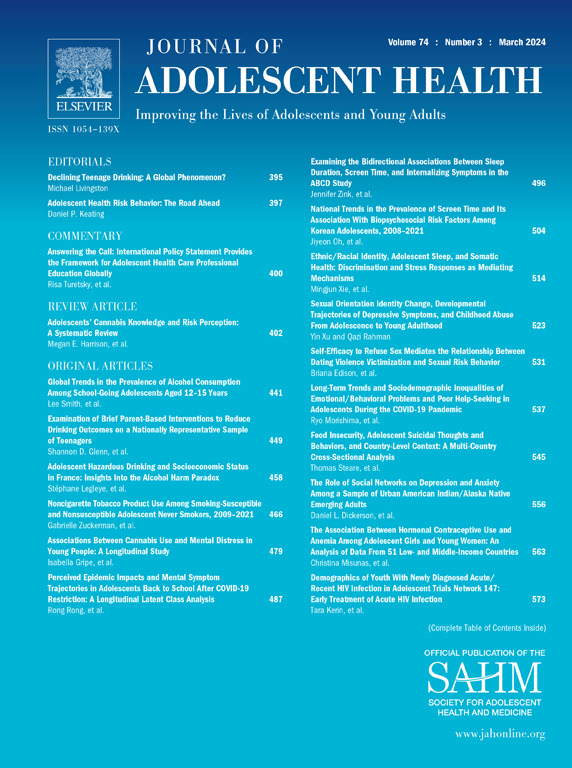Longitudinal Use Patterns of Technology Subtypes During the Transition Into Early Adolescence: Results From the Adolescent Brain Cognitive Development Study
IF 5.5
2区 医学
Q1 PEDIATRICS
引用次数: 0
Abstract
Purpose
Adolescents encounter a complex digital environment, yet existing data on youth technology use rarely differentiates technology subtypes. This study maps the evolution and intricacies of youth engagement with technology subtypes.
Methods
N = 11,868 participants in the Adolescent Brain Cognitive Development study followed from ages ∼9/10 to ∼13/14. We examined youths' self-reported hours per day (hr/day) of technology subtypes: TV/Movies, video games, YouTube, social media, video chat, and texting. We used descriptive statistics and multilevel logistic regression to assess cross-sectional and longitudinal use patterns of technology subtypes, agreement between child and parent reports on the child's technology use, and associations between each technology subtype and sociodemographics (child's biological sex, parent education, income, and marital status).
Results
At age 9/10, ∼75% of youth reported minimal (<30 min/day) social technology use (social media, video chat, texting) and up to ∼1.5 hr/day of TV, video games, and YouTube. By age 13/14, TV trajectories were converging to >2 hr/day, but social technology trajectories “fanned out” into a wide range of usage rates. Child and parent reports were weakly correlated (rs range: 0.13–0.29). Using child-reported hours of technology use, increases in the subject-specific odds of using a technology >2 hr/day ranged from 25% (YouTube; 95% CI: 1.16–1.35) to 234% (social media; 95% CI: 3.14–3.55). Compared with males, females had ∼100–200% greater odds of >2 hr/day of social technologies, but ∼40–80% reduced odds of >2 hr/day of video games and YouTube. Higher parent education and income predicted significantly lower odds of >2 hr/day of use – regardless of technology subtype.
Discussion
Distributions of youths' self-reported technology engagement are highly contingent on technology subtype, age, and biological sex. Future research on youth development and technology may benefit from considering youths' varied digital experiences.
进入青春期初期技术亚型的纵向使用模式:青少年大脑认知发展研究的结果。
目的:青少年面临着复杂的数字环境,但现有的青少年技术使用数据却很少区分技术亚型。本研究描绘了青少年参与技术亚型的演变和复杂性:N=11868名青少年大脑认知发展研究的参与者,年龄从9/10岁到∼13/14岁。我们调查了青少年自我报告的每天使用技术亚类的时间(小时/天):电视/电影、视频游戏、YouTube、社交媒体、视频聊天和短信。我们使用描述性统计和多层次逻辑回归来评估技术子类型的横向和纵向使用模式、儿童和家长对儿童技术使用情况报告的一致性,以及每种技术子类型与社会人口统计学(儿童的生理性别、家长的教育程度、收入和婚姻状况)之间的关联:在 9/10 岁时,75% 的青少年报告说他们使用的技术很少(每天 2 小时,但社会技术的使用轨迹 "扩展 "到很大的使用率范围。儿童和家长的报告呈弱相关(rs 范围:0.13-0.29)。根据儿童报告的技术使用时长,每天使用技术超过 2 小时的特定主题几率增加了 25%(YouTube;95% CI:1.16-1.35)至 234%(社交媒体;95% CI:3.14-3.55)。与男性相比,女性每天使用社交媒体超过 2 小时的几率要高出 100-200% ,但每天使用电子游戏和 YouTube 超过 2 小时的几率要低 40-80% 。父母受教育程度和收入越高,每天使用社交技术超过2小时的几率就越低--不管是哪种技术子类型:讨论:青少年自我报告的技术参与度分布与技术子类型、年龄和生理性别密切相关。未来有关青少年发展和技术的研究可能会从青少年不同的数字体验中获益。
本文章由计算机程序翻译,如有差异,请以英文原文为准。
求助全文
约1分钟内获得全文
求助全文
来源期刊

Journal of Adolescent Health
医学-公共卫生、环境卫生与职业卫生
CiteScore
10.40
自引率
3.90%
发文量
526
审稿时长
46 days
期刊介绍:
The Journal of Adolescent Health is a scientific publication dedicated to enhancing the health and well-being of adolescents and young adults. Our Journal covers a broad range of research topics, spanning from the basic biological and behavioral sciences to public health and policy. We welcome a variety of contributions, including original research papers, concise reports, literature reviews, clinical case reports, opinion pieces, and letters to the editor. We encourage professionals from diverse disciplines such as Anthropology, Education, Ethics, Global Health, Health Services Research, Law, Medicine, Mental and Behavioral Health, Nursing, Nutrition, Psychology, Public Health and Policy, Social Work, Sociology, and Youth Development to share their expertise and contribute to our mission of promoting adolescent health. Moreover, we value the voices of young individuals, family and community members, and healthcare professionals, and encourage them to submit poetry, personal narratives, images, and other creative works that provide unique insights into the experiences of adolescents and young adults. By combining scientific peer-reviewed research with creative expressions, our Journal aims to create a comprehensive understanding of the challenges and opportunities in adolescent and young adult health.
 求助内容:
求助内容: 应助结果提醒方式:
应助结果提醒方式:


